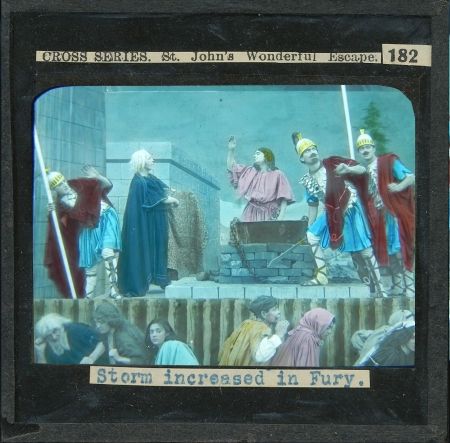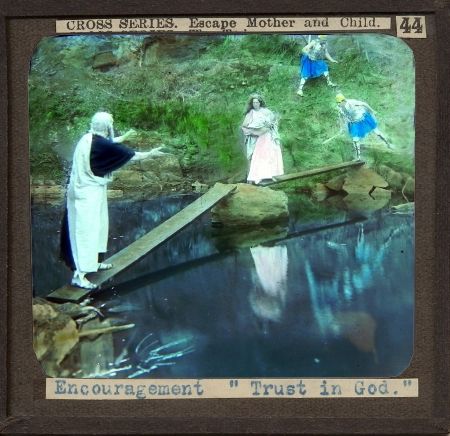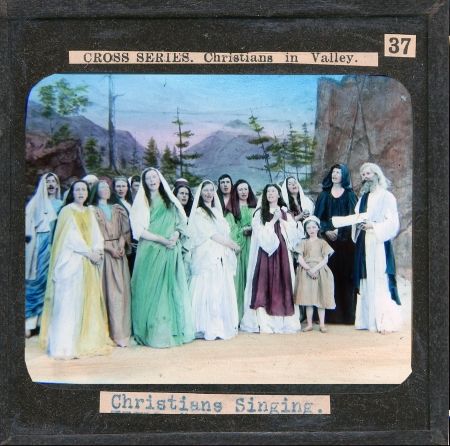'Find of the decade'

'Find of the decade'
12 June 2017
Southern Territory archivist Lindsay Cox with one of the rare lantern slides.
The discovery of rare lantern slides from the iconic Salvation Army film production, The Cross Series, has been described as the “find of the decade”, after being acquired by the Army’s Heritage Centre in Melbourne.
The lantern slides, as part of The Cross Series, were created by The Salvation Army’s Limelight Department between 1898 and 1908.
The Heritage Centre purchased 170 original Limelight Department lantern slides at auction late last year on eBay. Listed as “The Cross Series” by an independent seller, they were spotted by a delegate from the Magic Lantern Symposium in Korumburra, south-east of Melbourne, who alerted the Army’s Southern Territory archivist Lindsay Cox, that they were for sale.
Competition for the slides drove prices up substantially before they were acquired by the Heritage Centre, however, as Lindsay says, “Their uniqueness makes them a bargain at any price”.

The majority of the cost was covered by The Salvation Army Historical Society and several friends of the Heritage Centre. “They are the find of the decade,” Lindsay adds, “such is their importance – not just to the Army, or Australia, but internationally.”
The slides in The Cross Series were produced by Brigadier Joseph Perry. “The slides are unique as Brigadier Perry was producing the only ‘life-model’ lantern slides in Australia at that time,” Lindsay explains. “These life-model slides were produced by photographing real people dramatically staged on elaborate sets. The thousands of glass slides produced elsewhere across Australia at that time were merely coloured artistic illustrations and paintings.”

Several of the slides are original duplicates of a sequence from the 1900 production Soldiers of the Cross, which was described in The War Cry of 2 October 1900 in the following way: “A Christian woman, with babe in her arms, was being pursued by Roman soldiers. A path lay across a series of wooden planks forming a narrow bridge. A comrade of the faith on the near side of the stream encourages her to cross, and receives her with a steady grasp and presses her on in hurried flight. A soldier, who had outstripped his confederates, reached the bank and dashed across, forgetting to take into account the spring of the board under his weight and rapid movement, he suddenly loses his balance, and is seen flying through the air, and drops with a great splash in the stream. The tension of the audience thereat gave way to manifested gladness at the escape and the discomfiture of the poor woman’s pursuer.”

The acclaimed two-and-a-half-hour production of Soldiers of the Cross consisted of 19 monochrome film clips, each spanning 90 seconds, and more than 200 coloured lantern slides, the latter providing three-quarters of the screen-viewing time.
Acquiring the slides is another step in the Heritage Centre’s partnership with “A Million Pictures”, an international research project of several universities (including the Australian National University) aiming to address the preservation of the heritage resource of the tens of thousands of lantern slides in libraries and museums across the world.
“They (A Million Images) are as excited as I am about these lantern slides!” says Lindsay.
The Salvation Army Heritage Centre, located in Bourke St, Melbourne, holds all of the Limelight Department’s lantern slides known to be in existence, except for those from Soldiers of the Cross, which are owned by the National Film and Sound Archives in Canberra.
Limelight Department lantern slides are on exhibition at the restored, original Limelight photographic studio in the attic of 69 Bourke St, Melbourne.
Comments
Soldiers of the cross was taken to America many years ago and disappeared from there I was told this by an S A officer whose uncle was the person who actually took the film to America. My husbands grandmother actually acted in the film and also designed uniforms and costumes in the film. This lady was also married and became the mother of composer, arranger and conductor Wilbur Sampson and there came a lot of Sampson's to follow. There is a lot of info out there held by relatives if people ask the right people.